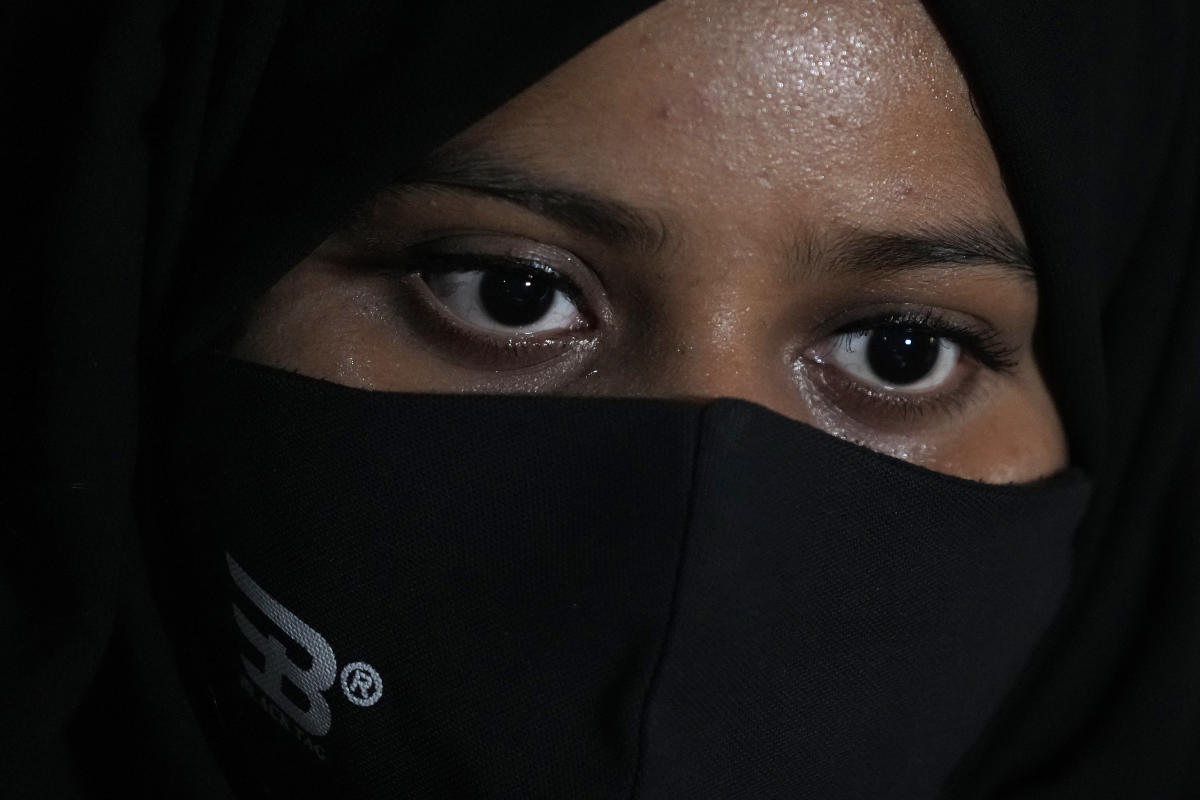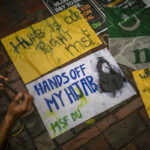
UDUPI, India (AP) — When Aliya Assadi was 12, she wore a hijab while representing her southern Indian state of Karnataka at a karate competition. She won gold.
Five years later she tried to wear one to her junior college, the equivalent of a U.S. high school. She never made it past the campus gate, turned away under a new policy barring the religious headgear.
“It’s not just a piece of cloth,” Assadi said while visiting a friend’s house. She wore a niqab, an even more concealing garment that veils nearly the entire face with just a slit for the eyes, which she dons when away from home. “Hijab is my identity. And right now what they’re doing is taking away my identity from me.”
She’s one of countless Muslim students in Karnataka who have found themselves thrust into the center of a stormy debate about banning the hijab in schools and the Islamic head coverings’ place in this Hindu-majority but constitutionally secular nation.
The issue has become a flashpoint for the battle over the rights of Muslims, who fear they are being shunted aside as a minority in India and see hijab restrictions as a worrying escalation of Hindu nationalism under Prime Minister Narendra Modi’s government.
The hijab is worn by many Muslim women to maintain modesty or as a religious symbol, often seen as not just a bit of clothing but something mandated by their faith. Opponents consider it a symbol of oppression, imposed on women. Hijab supporters deny that and say it has different meanings depending on the individual, including as a proud expression of Muslim identity.
The furor began in January in India, where Muslims make up just 14% of the country’s 1.4 billion people but are still numerous enough to make it the second-largest Muslim population of any nation, after Indonesia.
Staffers at a government-run junior college in Udupi, a coastal city in Karnataka, began refusing admission to girls who showed up in a hijab, saying they were violating the uniform code.
The students protested by camping outside and holding their lessons there, arguing that Muslim students had long been allowed to wear headscarves at school. More schools in the state soon imposed similar bans, prompting demonstrations by hundreds of Muslim women.
That led to counterprotests by Hindu students wearing saffron shawls, a color closely associated with that religion and favored by Hindu nationalists. They shouted slogans like “Hail Lord Ram,” a phrase that traditionally was used to celebrate the Hindu deity but has been co-opted by nationalists.
At one campus a boy climbed a flagpole and hoisted a saffron flag to cheers from friends. At another a girl in a hijab was met by shouted Hindu slogans from a group of boys; she raised her fist and cried, “Allahu akbar!” — “God is great,” in Arabic.
To quell tensions the state, governed by Modi’s Bharatiya Janata Party, shut schools and colleges for three days. It then slapped a statewide ban on the hijab in classes, saying “religious clothing” in government-run schools “disturbs equality, integrity and public law and order.”
Some students gave in and attended with their heads uncovered. Others refused and have been barred from school for nearly two months — students like Ayesha Anwar, an 18-year-old in Udupi who has missed exams and is falling behind her peers.
“I feel like we are being let down by everyone,” Anwar said while surrounded by friends in a dimly lit cafe, her voice barely a whisper from behind her cloth veil.
Six students sued to overturn the state’s ban, arguing it violates their rights to education and religious freedom. An Indian court Tuesday upheld that ban, saying the Muslim headscarf is not an essential religious practice of Islam.
One of the plaintiffs to the challenge was Aliya Assadi.
“I’m an Indian and a Muslim,” she said. “When I see this with the point of view of a Muslim, I see my hijab is at a stake, and as an Indian, I see my constitutional values have been violated.”
There’s a cost to her activism: Hindu nationalists doxxed her personal details on social media, unleashing a flood of online abuse and harassment. She lost friends who depicted her actions as Muslim fundamentalism.
But she’s steadfast about wearing the hijab. She first did so as a child, imitating her mother, carefully arranging the headscarf in front of the mirror each morning. Today she enjoys the privacy it affords and the sense of religious pride it conveys: “It makes me confident.”
Ayesha Imtiaz, another student barred from school, said she wears it as a token of devotion to Islam but acknowledged that opinions vary even among Muslim women.
“There are so many of my friends who do not wear hijab inside the classroom,” said Imtiaz, 20. “They feel empowered in their own way, and I feel empowered in my own way.”
In her eyes, the bans segregate women according to faith and contravene core Indian values on diversity.
“It’s Islamophobia,” Imtiaz said.
Hijab restrictions have surfaced elsewhere, including France, which in 2004 banned them in schools. Other European countries have enacted regulations for public spaces, usually aimed at the more concealing garments such as niqabs and burqas. Usage of head coverings has divided even some Muslim communities.
In India, the hijab has historically been neither prohibited nor limited in public spheres. Women donning the headscarf is common across the country, which has religious freedom enshrined in its national charter with the secular state as a cornerstone.
But critics of Modi say India has steadily drifted from that commitment to secularism and today is deeply fractured along religious lines. The prime minister and top Cabinet officials often perform Hindu rituals and prayers on television, blurring the lines between religion and the state.
Since coming into office in 2014, Modi’s government has passed a raft of laws that opponents call anti-Muslim, though his party rejects accusations of being discriminatory.
Meanwhile calls for violence against Muslims have moved from society’s fringes toward the mainstream. Watchdog groups such as Human Rights Watch and Amnesty International have warned that attacks could escalate against Muslims, who are disproportionately represented in India’s most impoverished neighborhoods and in prisons.
Some of the anti-Islam sentiment has specifically targeted women — recently many in the country were outraged by a website that was set up offering a fake “auction” of more than 100 prominent Indian Muslim women, including journalists, activists, artists and movie stars.
Muslim students allege that behind the counterprotests in Karnataka was Hindu Jagran Vedike, a nationalist group associated with Rashtriya Swayamsevak Sangh, a far-right Hindu organization ideologically linked to Modi’s political party.
Mahesh Bailur, a senior member of Hindu Jagran Vedike, denied that his group organized demonstrations and said it only offered “moral support” to the saffron shawls and their cause.
“Today these girls are demanding hijab in colleges. Tomorrow they will want to pray there. Finally, they’ll want separate classrooms for themselves,” he said. “This is unacceptable.”
Bailur, 36, is a proponent of a discredited conspiracy theory that holds Muslims are plotting to convert India’s Hindu population and eventually remake it as an Islamic nation. Demands to wear the hijab in classes, he argued, are part of that.
Manavi Atri, a human rights lawyer based in Bengaluru, the capital of Karnataka, said the hijab ban is among many assaults on expressions of Muslim identity in India today, violates principles of state neutrality on religious matters, and inflates an “us-versus-them philosophy” in a country already riven by sectarian divisions. Most troubling, she said, is the pressure it puts on girls and young women in their formative years.
“This choice (between education and faith) that people are being forced to make is not a choice one has to be exercising at that age,” she said.
In the court case, lawyers for Karnataka state argued that the Quran does not clearly establish wearing the hijab as an essential spiritual practice, so banning it does not violate religious freedom.
Many Muslims reject that interpretation.
On a recent Friday, Rasheed Ahmad, the head imam of Udupi’s grand mosque, delivered a sermon before hundreds of worshippers. His voice thundering through loudspeakers mounted on the minarets, he railed against the bans as an attack on Islam.
“Hijab is not just our right,” he said later in an interview, “but an order from God.”
Assadi said she and the others are determined to prevail.
“We are brave Muslim women,” she said, “and we know how to fight for our rights.”
___
Associated Press religion coverage receives support through the AP’s collaboration with The Conversation US, with funding from Lilly Endowment Inc. The AP is solely responsible for this content.




